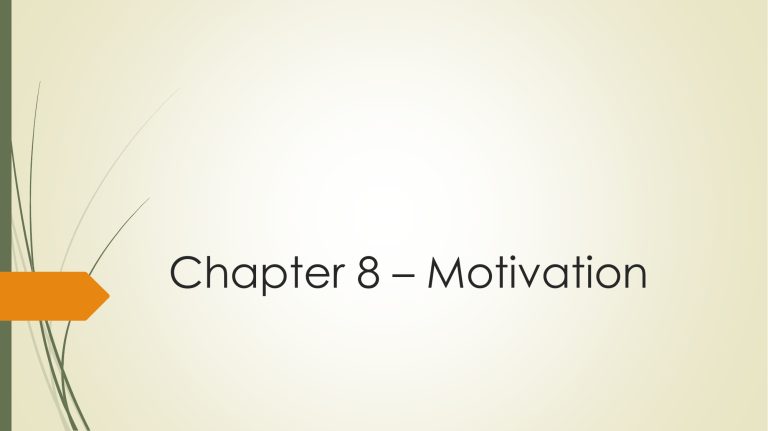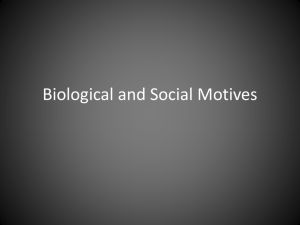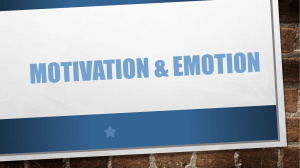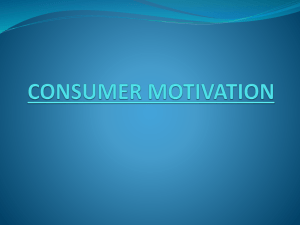
Chapter 8 – Motivation Table of contents What is motivation Types of motives Theories of motivation Consumer motivation Emotions & moods in organizations What is motivation? Motivation refers to a process of inducing and stimulating an individual to act in a certain manner. In the context of an organization, motivation implies encouraging and urging the employees to perform to the best of their capabilities so as to achieve the desired goals of the organization. Motivation reflects something unique about each one of us and allows us to gain valued outcomes like improved performance, enhanced wellbeing, personal growth, or a sense of purpose. Motivation is a pathway to change our way of thinking, feeling, and behaving Types of Motivation Intrinsic Extrinsic This is known as internal motivation Aka external motivation It comes from within Comes from want or gain of a reward It refers to when an individual does something for their own sake because it aligns with their interests, passions or personal values It refers to when an individual is motivated to perform an activity in order to gain something external Driven from within Driven externally Deeper purpose and fulfillment Surface level More likes on social Focused on end result Only seeing how this effects your present Theories of Motivation Needs-based motivation Reflect a content perspective Try to list specific things that motivate behavior Process-based theories Focus on how motivated behavior occurs Explain how people go about satisfying their needs Theories of Motivation Expectancy Theory The expectancy theory of motivation suggests that when we are thinking about the future, we formulate different expectations about what we think will happen. When we predict that there will most likely be a positive outcome, we believe that we are able to make that possible future a reality. This leads people to feel more motivated to pursue those likely outcomes. The theory proposes that motivations consist of three key elements: Valence: the value people place on the potential outcome Instrumentality: whether people believe that they have a role to play in the predicted outcome Expectancy: the belief that one has the capabilities to produce the outcome Humanistic Theory Humanistic theories of motivation are based on the idea that people also have strong cognitive reasons to perform various actions. This is famously illustrated in Abraham Maslow's hierarchy of needs, which describes various levels of needs and motivations. Maslow's hierarchy suggests that people are motivated to fulfill basic needs before moving on to other, more advanced needs. For example, people are first motivated to fulfill basic biological needs for food and shelter, then to progress through higher needs like safety, love, and esteem. Once these needs have been met, the primary motivator becomes the need for selfactualization, or the desire to fulfill one's individual potential. Maslow was interested in learning about what makes people happy and the things that they do to achieve that aim, rather than focusing on problematic behaviors. Arousal Theory The arousal theory suggests that people take certain actions to either decrease or increase levels of arousal. When arousal levels get too low, for example, a person might watch an exciting movie or go for a jog. When arousal levels get too high, on the other hand, a person would probably look for ways to relax, such as meditating or reading a book. According to this theory, we are motivated to maintain an optimal level of arousal, although this level can vary based on the individual or the situation. Drive Theory According to the drive theory of motivation, people are motivated to take certain actions in order to reduce the internal tension that is caused by unmet needs. For example, you might be motivated to drink a glass of water in order to reduce the internal state of thirst. The drive theory is based on the concept of homeostasis, or the idea that the body actively works to maintain a certain state of balance or equilibrium. This theory is useful in explaining behaviors that have a strong biological or physiological component, such as hunger or thirst. The problem with the drive theory of motivation is that these behaviors are not always motivated purely by drive, or the state of tension or arousal caused by biological or physiological needs. For example, people often eat even when they are not really hungry. Instinct Theory of Motivation According to instinct theories, people are motivated to behave in certain ways because they are evolutionarily programmed to do so. An example of this in the animal world is seasonal migration. Animals do not learn to migrate to certain places at certain times each year; it is instead an inborn pattern of behavior. Instincts motivate some species to do this. William James identified a list of human instincts that he believed were essential to survival, including fear, anger, love, shame, and modesty.1 The main problem with this theory is that it did not really explain behavior, it just described it. James presumed that we act on impulse, but that leaves out all the learning/conditioning that informs behavior. By the 1920s, instinct theories were pushed aside in favor of other motivational theories, but contemporary evolutionary psychologists still study the influence of genetics and heredity on human behavior Types of motives Psychologists have divided motives into three types: 1. Biological motives 2. Social motives 3. Personal motives Consumer Motivation How to determine consumer motivation? It’s easy to determine customer motivation by examining your store’s internal data. Here’s what you need to know. Look at your customer personas With a little common sense, you can use your personas to pinpoint or rule out buyer motives. For personas on a budget, pleasure and acceptance probably won’t be as important as need or financial gain. Fear may drive the likes of parents, businesses and workers to make a purchase, whereas older audiences are likely to be motivated by health concerns. Gather further insights You can delve further into buyer motives by running surveys, monitoring feedback, conducting interviews, performing competitor analysis and other kinds of market research. Analyze or A/B test marketing messages which tap into different buyer motives to see which receive the most engagement. You can also check out the pages your visitors view most. It's a good idea to engage with your support agents to find out what customers say about your products too. The questions they ask before conversion can be particularly helpful for determining pre-purchase motivations. Take advantage of tech tools Your eCommerce brand can leverage advanced analytics and machine learning to accurately identify important demographics and consumer behavior, which can then be used to supercharge customer personas and buyer motives. A Digital Shelf monitoring tool allows you to analyse reviews across your entire sales network in an effort to understand why past customers bought your products. Tracking keyword phrases related to your brand and products can also highlight your audience’s motives. Tips to leverage buyer motivation Armed with knowledge of what motivates your customers, your team can create content that will speak directly to their needs. Here are three ways to capitalise on this: 1. Tailor your content Different personas are likely to have different buyer motives. But you can tailor your messages to each one with some simple eCommerce personalisation. Based on the product chosen or the marketing message clicked, you can present shoppers with custom landing pages, promotions, pop-ups, cross merchandising messages and content suggestions. 2. Create urgency at checkout We already touched on how flash sales and limited offers can boost impulse purchases. But marketers can also use the checkout experience to motivate prospects to act fast. Let shoppers know when an item in their cart is running low and implement countdown timers to communicate when sales end, offers expire or delivery deadlines approach. One study indicates that this can increase conversions by 9%. 3. Link savings and sustainability It’s not only budget brands that can provide consumers with financial gains. High-end merchants are also tapping into this buyer motivation by highlighting how their products save money in the long-term. The North Face, JanSport, Zippo, Skullcandy and DeWalt all offer lifetime warranties, while brands like LG and Miele work hard to highlight how much their energy efficient appliances can save consumers. With sustainable eCommerce being a huge trend right now, showcasing your green credentials. Emotions and moods in the workplace Emotions and moods can have a significant impact on decision making in the workplace. When employees are feeling positive, they are more likely to take risks and be innovative. However, when employees are feeling negative, they are more likely to play it safe and stick to established procedures. Emotional intelligence can help managers to create a positive emotional culture in the workplace. By promoting emotional awareness and encouraging employees to express their feelings, managers can create a positive emotional culture where employees feel comfortable making decisions. In addition, emotional intelligence can help managers to identify when employees are feeling overwhelmed or stressed, and provide support to prevent them from making poor decisions. How to differentiate between mood and emotions in the workplace? Moods Moods can be positive or negative, and they can affect both our facial expressions and body language. If someone is in a bad mood, they might have a frown on their face and their body might be tense. If someone is in a positive mood, they might have a smile on their face and their body might be relaxed. Emotions Emotions, on the other hand, are usually more intense and can be triggered by something as small as a colleague saying something rude. In this way, emotions can be viewed as a healthy fluctuation that we can train ourselves to overcome once they've been felt. With mood, there can be more deep-rooted causes to deal with.




